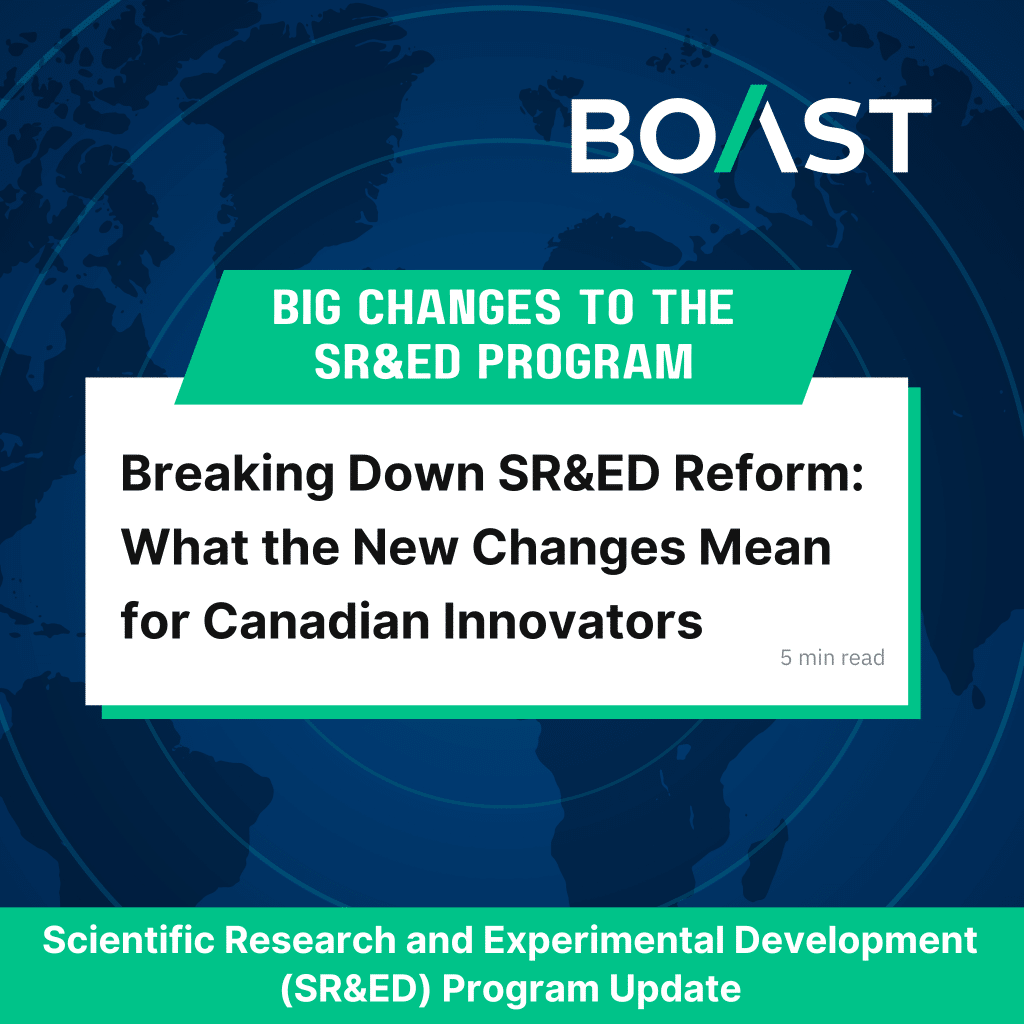Each year, governments around the world provide billions of dollars to innovative businesses for developing new or improving existing technologies, products, materials, and processes through research and development (R&D) tax credit programs.
Since every business needs capital for innovation and growth, claiming R&D tax credits is one of the cheapest ways to maximize capital and reduce tax liabilities.
In some situations, the R&D tax credits come back to a business in the form of cashback, and in other cases, the tax credits come as a payroll offset or other form of tax liability dilution. In any event, businesses that are inventing something new, taking risks, or investing in the development of technology, usually qualify. For SaaS companies, government tax credits are a fantastic way to get a chunk of your R&D or SR&ED (scientific research and experimental design—Canada’s government tax credit program) investment back.
Governments made many of these programs permanent in 2015-2016 because they realized that supporting innovation is supporting job growth. But what does it take to qualify and claim these credits?
As part of a yearly tax claim submission, SaaS businesses may be required to provide reports outlining the time and costs attributed to new innovations over the past year. These records are found in GitHub, Jira, or other project management systems. Costs are tracked through payroll systems because the main R&D costs for SaaS businesses are the salaries of their developers.
For work to be considered innovative or research and development, there must be elements of creating something new, risk of potential failure, and challenges to overcome—that’s why it’s called R&D. These include:
Advancing Technology
The work carried out in the experimental development activity must generate information that advances your understanding of underlying technologies and furthers technical knowledge. In a business context, this means that when new or improved material, device, product, or process is created, it must embody a technological advancement in order to be eligible.
Technological Uncertainty
Technological obstacles/uncertainties are the technological problems or unknowns that cannot be overcome by applying the techniques, procedures, and data that are generally accessible to competent professionals in the field. In other words, any qualified person working on the project must overcome technical challenges with their existing knowledge.
Technological Content
To be eligible, the project has to have been conducted in an iterative, systematic process with documentation. A typical process involves identifying the unknowns or challenges, forming a hypothesis about how to solve those challenges, testing and experimentation, and an analysis of the process to reach your conclusion.
In a business context, this requires that the objectives must be clearly stated at an early stage in the evolution of a project and the method of addressing the unknown must be clearly set out.
What Can You Recover with R&D Tax Credits?
The R&D tax credits you can recover vary by country. For the U.S. it breaks into the Federal and State. The Federal portion is approximately 10% of eligible expenditures that can be used to offset Social Security taxes up to $250,000 per year, income taxes, or alternative minimum tax (AMT). However, the State portion differs from state to state. Calculate U.S. R&D tax credits.
For Canada, businesses can recover up to 64% of their R&D spending under the Canadian Government’s SR&ED program. Other countries and regions, such as The U.K., Australia, and Brazil have similar programs. Calculate Canadian SR&ED tax credits.
COVID has made things interesting for tax credit claims. While many SaaS businesses have been impacted by COVID, those businesses have also responded to stay relevant, helpful to customers, or profitable. That response often takes the form of innovation, which can be supported by government tax credits programs.
SaaS companies can claim the following general areas related to their R&D:
- Salaries: The company makes regular payments to employees
- Sub-contractor fees: The company contracts with an arm’s length party to perform R&D or SR&ED eligible work
- Materials: Materials consumed or transformed in the process of R&D or SR&ED eligible work
How Much Would a Software Company Claim?
Company ABC is developing a software platform to integrate their customer relationship management system and their operations management system. These systems were not developed to work together so there have been some significant challenges. They have 4 developers (one front-end and three back-ends) working on this project 75% of their time. They are employees and their salaries are $75,000 per year.
Front-end development work is not typically eligible for SR&ED claims, so we will not count the front-end developers’ salary. However, every situation is different, so please contact your Boast for a custom assessment. Excluding the front-end developer, Company ABC can claim $225,000 ($75,000 x 3) worth of salaries for their claim. Since the developers spend 75% of their time on eligible items, we reduce the eligible salaries expenditure pool to ~$169,000 ($225,000 x 75%). Company ABC could qualify for ~$109,000 worth of tax credits. Read more.
Examples of Qualifying Tax Credit Work for SaaS Companies
- Creating new systems and processes to power hardware devices
- Coding IoT networking solutions
- Designing and development of CRMs, ERPs, HRS, etc.
- Designing and development of compliance systems
- Healthcare systems application development
- Development of financial and accounting software
- Development of monitoring systems
- Development and integration of databases
- Developing messaging technologies
- Building quality assurance or testing environments
- Developing new or improved technologies (e.g., new algorithms or methodologies)
- Designing and development of new or improved software applications and architecture
- Internal-use software development
- Development of e-commerce systems
- Developing data mining techniques including big data analysis and processing
- Development of document management systems
- Development of education-based software
Where to Begin?
Your finance department may already have the information you need to start a tax credit claim, but you will also need to gather data from engineering project tickets and classify them into subgroups. Once done, assigning the right people and time to each new invention is next.
Although the claims process can take some time, the benefits can be worth it. Receiving cashback for R&D spending can mean hiring more developers more quickly, innovating faster, and growing faster. And innovating faster and getting to market quicker has a direct and positive impact on a SaaS business’s valuation.
There are five clear benefits for pursuing tax credits as a SaaS business:
- The R&D tax credits cashback refund or the carry-forward credit for 20 years, applied dollar-for-dollar to future cash tax liability
- Financial asset for reporting purposes
- Improves future cash flow metrics
- Increases M&A valuation multiples
- Fosters organizational process for R&D documentation, transparency, and accountability
Ultimately, the decision to pursue and accumulate R&D tax credits for your SaaS business has broader implications than on the surface, such as a cash-back refund. Consider, for example, the future value of assets and how they could impact different business outcomes that your organization could encounter. The benefit of accumulating R&D tax credits easily outweighs any cost to pursue them.
- Read about SaaS company Neo Financial’s focus on R&D and their use of tax credits
- Read more from the U.S. Tax Foundation about R&D tax credits
- Connect with how Boast helps software and gaming companies collect their eligible tax credits
Boast Can Help Maximize Your SaaS-Eligible Tax Credit Claims
Boast helps organizations accelerate innovation using government R&D tax credits and R&D intelligence. Boast software integrates financial, engineering, and project tracking data to increase the speed, accuracy, and size of eligible R&D tax credits.
Boast removes the mystery, complexity, and difficulty from the process to become an R&D source of truth. With operations across the U.S. and Canada, more than 1,000 innovative companies have leveraged Boast to get more money, faster, for less time and risk. Talk to a Boast representative.




